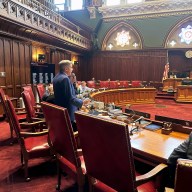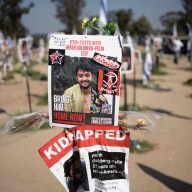Author Cassandra Clare admits pitching a young adult novel with steampunk themes set in Victorian England isn’t necessarily the most commercially viable idea.
“I had to find 10 or 12 books that were crossover titles or teen titles that had a Victorian backdrop to prove that this thing was saleable,” Clare recalls of the pitch for her latest novel, “Clockwork Angel.” “There was doubt, but as it sits [on the bestsellers chart], the publisher is pretty happy,” she laughs.
Of course, Clare already had McElderry Books (an imprint of Simon & Schuster Children’s) on her side. She is the author of the bestselling “Mortal Instruments” series, an urban fantasy trilogy about the Shadowhunters, demon-hunting descendants of angels who fight to keep balance between humanity and the supernatural realm in modern-day New York City (the M.I. series will close with six books in total). “Clockwork Angel” transports the Shadowhunters to 1800s London and serves as the first book in the “Infernal Devices” prequel series, so a devoted audience was inherent. But a plug from Stephenie Meyer, author of the “Twilight” saga, never hurts, either.
“Once Stephenie started talking about [the Shadowhunter books], more people who are romance fans came to them,” says Clare, whose novels all bear a cover blurb from Meyer. “Before they may have looked at my books and thought ‘fantasy, demon-hunting’ rather than ‘romance.’ But really it’s a romance with an action-adventure background.”
Q and A”:
On writing a book set in the Victorian England that teens today would get sucked into:
Teens would not really be enthused with my attempt to replicate slang in a quaint style of dialogue. I went with not using any anachronistic terms or idioms that would not have existed or phraseologies or idioms that would not have existed, but keeping the characters’ speech simple and straightforward. I read all of the Sherlock Holmes books because if you excerpt a chunk of dialogue, it’s very easy for a modern reader. Though they were written in 1890, there’s nothing that tags them as being particularly old- fashioned. There’s a structural difference and obviously there are words they wouldn’t use. I went with trying to imply the Victorian-ness with the structure of the dialogue while keeping the language clear and straightforward.
Once this was done, I had it read by a Victorian historian and two friends who had written a bunch of historical fiction. And there were things they did note that didn’t sound Victorian. But I had them read it over just to check on my dialogue. I was very paranoid.
On writing great action scenes:
I love action. Writing fight scenes is really hard for me, but they’re important. I love them when I’m done, but the blocking of the scenes is really difficult. So before I wrote the first book, I had a long conversation with a guy who was a fight coordinator for plays. We would talk about how you make the action work and how to remember where everyone’s standing and what’s going on. Even now when I’m working on a fight scene it helps to have a friend around to act out this fight scene and make sure this would actually work. More than once I’ve been at my friend Holly’s house and we act out a fight scene and her husband comes home and says, “I don’t even want to know why you’re fighting each other in the living room.”
On interacting with her audience online:
The most significant part [of being a successful young adult author] is to create a good book. But you do have to set aside time for social networking and Internet promotional stuff, because last time I went on tour, I received letters from the booksellers, “Could you please disseminate the information about the tour, where we’re located,” and all that, because teenagers don’t find out about book signings and book releases from bookstores anymore. They find out about them from authors on the Internet. So you kind of have to maintain a presence.
And the best part about writing for kids is they’re really sweet. They write me great fan mail. A lot of them have interesting, intelligent questions. But I’m a little jealous. When I was a kid growing up and I wanted to be a writer, there was no Internet. They look at me like, you know, I’m talking about the Flintstones and I had to drive my car with my feet. And now there are all these places to go to share their writing and get advice, which I think is great.
On the popularity of young adult novels among readers of all ages:
I think “Harry Potter” started to tip the scale, but “Twilight” tipped it all the way over. “Twilight” has an adult-friendly cover, it has the beautiful, simple design that no one would feel embarrassed to carry around. It knocked down the barriers between the young adult sections and the rest of the store. “Twilight” marked the time that bookstores started moving their teen sections out of children. They’ve got their own section now. In fact, they’ve broken other teen books into other sections — for instance, Barnes & Noble, with “Clockwork Angel,” they did a ladder, which means when you walk into the store, there are books on vertical shelves which are the first thing you see on either side of the info desk. Usually they feature Stephen King, that kind of thing. They did that with “Clockwork Angel.” They were like, we’re going to devote a ladder every month to a YA book because they noticed this big overlap. They’re like, “We’re relaying the message that these books are for everybody.”
















